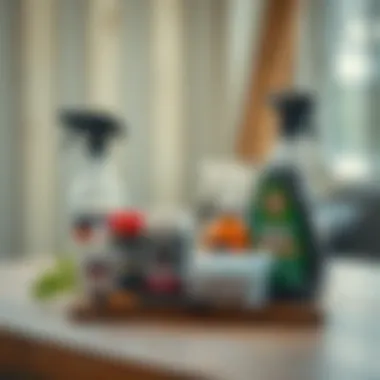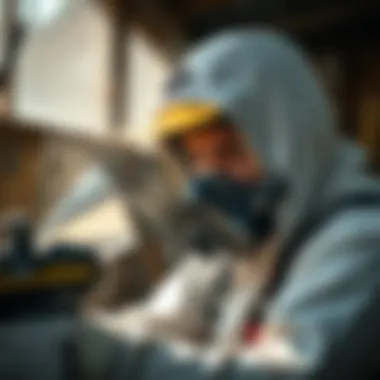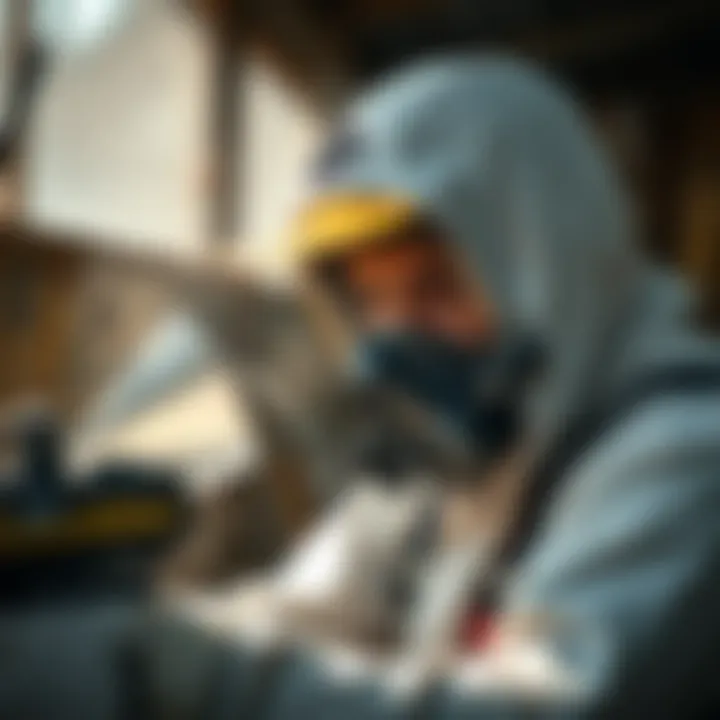Comprehensive Guide to Pest Control in Crystal River


Intro
Pests can be a real pain in the neck for homeowners in Crystal River, Florida. The warm climate and lush surroundings make the area a playground for various critters. Termites, mosquitoes, and even raccoons tend to make their presence known, often causing frustration for residents. This guide is designed to shed light on the pest control ecosystem unique to this region, offering a comprehensive insight into identifying these pests, effective prevention strategies, and various control methods you can adopt.
The sun-soaked atmosphere of Crystal River might seem idyllic, but that also opens doors for unwelcome guests. Whether you’re a homeowner seeking solutions or a curious reader wanting to know how this all works, you’re in the right place. This article will equip you with practical tips catered to your needs while, importantly, keeping ecological impacts in mind.
So let’s dive deeper into understanding the pest problems relevant to this area—because knowledge is half the battle.
Preface to Pest Control in Florida
Pest control is an essential topic in Florida, especially for residents in areas like Crystal River. As locals know, Florida's unique climate and environment create a ripe setting for various pests. Understanding how to manage these invaders is crucial for maintaining a healthy home and ecosystem. In this section, we’ll explore the significance of effective pest control measures and introduce key considerations relevant to homeowners.
Overview of Pest Control
The pest control landscape in Florida is as diverse as its geography. From termites gnawing at wooden structures to mosquitoes buzzing about during dusk, pest issues can arise at any time of the year. The state's warm, humid climate is a natural breeding ground for many pests, making it crucial for homeowners to stay vigilant.
Pest control encompasses a range of strategies aimed at managing unwanted creatures that invade residential and commercial properties. This can include physical removal, chemical treatments, and preventive measures designed to minimize infestations. A holistic approach, integrating various techniques, often yields the best results. By recognizing the signs of pests early and implementing timely solutions, homeowners can save themselves from significant headaches down the line.
Furthermore, pest control isn't just about removing nuisances. It's also about safeguarding the health of the residents and protecting property value. Infestations can lead to structural damage and unsanitary living conditions, which can pose risks to the well-being of all who inhabit the space.
Importance of Regional Knowledge
Having a clear understanding of regional pest behaviors and population trends is a game changer in pest control. Crystal River, nestled in Florida’s west coast, offers a unique set of challenges when it comes to pest management. Local flora and fauna influence which pests might be encountered and at what times of the year.
For instance, some pests thrive in the warmer months, while others may be more prevalent in the milder temperatures of fall and winter. Knowing the typical patterns of common pests in your area—be it the notorious fire ant or the elusive bed bug—allows for better preparedness.
Moreover, local pest control regulations may vary, requiring specific licenses or methods that are unique to the region. Familiarity with these laws not only ensures compliance but can also optimize pest management strategies. Local pest control services often have specialized knowledge of regional pests and can provide tailored advice, helping homeowners make informed decisions that best suit their circumstances.
Understanding both the variety of pests and the climate influences in Crystal River are key in effectively managing a pest-free environment. Educating oneself about local conditions can empower homeowners to engage in proactive measures, thus mitigating the adverse effects pests can impose on both property and health.
Understanding Crystal River's Pest Landscape
Understanding the pest landscape in Crystal River is crucial for homeowners, especially in a region where humidity and warmth create ideal conditions for various pests. Knowledge of local pests and their behavior not only helps in prevention but also in effective management. When residents grasp the nuances of pest populations, they can better adapt their strategies for keeping their homes safe.
Geographical Factors Influencing Pest Presence
Crystal River's unique geographical features play a significant role in pest presence and activity. The area is abundant with natural water sources, like the Crystal River itself and springs that serve as breeding grounds for many insects. Furthermore, the lush vegetation surrounding residential zones provides rich habitats for pests. These factors create a perfect storm for pest infestations.
The subtropical climate, characterized by wet summers and mild winters, not only supports a variety of plant and animal life but also fosters pest reproduction. Elevated temperatures during summer can lead to rapid population growth in common pests such as ants, mosquitoes, and termites. Understanding these geographical aspects allows homeowners to be more proactive and prepared for potential pest issues, thus maintaining a healthier living environment.
Common Pests in Crystal River
In Crystal River, several pests are more prevalent, and knowing them helps residents tackle pest problems more effectively. Here are some of the common pests found:
Rodents
Rodents are often seen as a nuisance in many households. These creatures, particularly rats and mice, can infiltrate homes, posing health risks and causing significant property damage. One of their key characteristics is their ability to reproduce rapidly; a pair of mice can lead to an explosion in numbers in no time. This high reproductive rate makes them a pressing concern for residents.
In terms of their contribution to pest control efforts, early detection is vital. Within the context of this guide, focusing on preventative measures such as sealing entry points and keeping food stored safely can make a marked difference. Plus, it’s essential to identify signs of rodent activity, like droppings or gnaw marks, as these can indicate the beginning of a problem.
Termites
Termites can be the bane of homeowners in Crystal River, readily consuming wood and compromising structures. Their silent nature is a significant disadvantage; they can dig their way into wooden beams and frames without anyone noticing until significant damage has been done. The key feature of termites is their social structure. They operate in colonies making it essential for pest control practices to focus on colony elimination rather than just addressing visible signs.
Understanding their potential to cause structural damage emphasizes the need for proactive inspection, especially during the warmer months when they are most active. This article will explore integrated pest management solutions, which include timely inspections to catch these wood-eaters before they cause havoc.
Ants
Ants, particularly in Florida, are uninvited guests that can infiltrate homes in droves. They can become a frustrating issue, especially during their mating season, which typically erupts in the warmer months. Foremost among their characteristics is their hardworking nature and ability to locate food sources rapidly, leading to large trails that can be seen in kitchens and pantries.
Ants provide a unique challenge because various species can infest homes, including sugar ants and fire ants, each needing different management strategies. It's beneficial for homeowners to identify the ant species to deploy effective methods like baiting or environmental modifications to deter them.
Bed Bugs
Bed bugs may be small, but their impact on homeowners is anything but. These pesky pests thrive in mattresses, linens, and furniture, often hitching a ride in luggage and second-hand items. One key trait of bed bugs is their resilient nature; they can survive for months without feeding, making them difficult to eliminate once they've established a presence.
Understanding their behaviour is a crucial component in pest management. For example, regular inspections and maintaining cleanliness can act as preventatives against infestations. However, once bed bugs are present, comprehensive treatment by professionals often becomes necessary, which is worth discussing in detail as this article unfolds.
Wasps
Wasps, like yellow jackets and paper wasps, are common intruders in Crystal River, especially during the late summer months. Their aggressive defense of nests can create safety concerns for families. A notable characteristic of wasps is their ability to sting multiple times, causing painful reactions for those unfortunate enough to get too close.
Their nests can be hidden in attics, eaves, or shrubs, making it crucial for homeowners to recognize the signs of wasp activity. Identification of nests and understanding wasp behaviour can help in reducing the risks associated with wasp encounters. Knowledge here is empowering as it enables homeowners to take appropriate action rather than living in fear of stings.
The awareness of common pests can aid in implementing effective pest control strategies, paving the way for safer and healthier homes in Crystal River.
By understanding these common pests and their specific characteristics, homeowners can develop targeted strategies to effectively control them, thereby safeguarding their homes and ensuring a more pleasant living environment.
Identification of Pests
Identifying pests is a crucial element of effective pest control, particularly in a unique ecosystem like Crystal River, Florida. Knowledge about pest identification helps homeowners prevent infestations before they spiral out of control. Knowing what you're dealing with not only guides the treatment process but also helps in choosing the right tactics.
The ability to accurately identify pests can save you time, money, and headaches. Without proper identification, homeowners might waste resources on ineffective solutions. Moreover, some pests might look similar, making it important to discern between, say, a termite and a harmless insect. This brings us to the importance of understanding pest behavior, habitats, and their potential threats to your home.
Signs of Infestation
Detecting early signs of an infestation can be the difference between a small problem and a full-blown ordeal. Some typical indicators homeowners should be vigilant about include:
- Droppings: This can vary depending on the pest. For instance, rodent droppings are small and pellet-shaped, while cockroach droppings may look like little black seeds.
- Nesting materials: Chewed-up paper, fabric, or bedding found in hidden corners can signal rodent infestation.
- Hollow sounds: If it sounds like there's knocking coming from the walls, it could be termites munching away.
- Damage: Signs of gnawing, chewed wires, or even small holes in walls can hint at rodent activity, while muddy tubes outside your home can indicate termites or ants.
- Skin or Casings: Finding shed skins from bed bugs or other insects means they’re likely lurking nearby.
"Recognizing these signs early can save you a lot of trouble down the road. Ignoring them can make a small headache into a migration problem."
Homeowners should also remember that the signs of infestation can often mimic common household issues. For instance, water stains may not only suggest a roof leak, but also a pest problem. Staying observant is key.
Techniques for Accurate Identification


Once signs of infestation are noted, it’s vital to employ accurate identification techniques to determine which pest is causing the issue. Here are some effective techniques:
- Physical Inspection: Conduct a thorough check of common areas like attics, basements, and closets. Look for droppings, nests, or damage.
- Using Traps: Set traps specific to the suspected pest. For example, sticky traps work well for spiders, while snap traps are more suited for rodents.
- Consulting Professionals: If doubts arise, it's worth consulting pest control experts who can employ advanced methods of identification, such as thermal imaging or bait stations.
- Online Research: Websites devoted to pest identification often allow homeowners to compare images and characteristics, aiding in self-diagnosis. Resources like Wikipedia can provide additional insights into the nature of specific pests.
- Community Forums: Engaging in local forums like those on Reddit can also yield tips and advice from individuals who have faced similar pest issues.
Understanding these techniques leads to more effective pest management strategies, ultimately creating a healthier living environment.
Professional Pest Control Services
The focus on professional pest control services can’t be overstated, especially in a region like Crystal River, where the unique climate and ecology foster a variety of pest issues. This section delves into the significance of employing professional services effectively, highlighting their role in tackling pest infestations, from ants invading the kitchen to more serious threats like termites lurking in the walls.
Pest control is not just about eliminating pests; it’s also about preventing future infestations and ensuring the safety of your home and family. Professional services often bring specialized knowledge, experience, and tools that homeowners don’t typically possess. In a place like Crystal River, where the humidity can create ripe conditions for pests to thrive, having a trained eye to seek out potential problems can be invaluable.
Choosing the Right Pest Control Company
Deciding on a pest control company involves more than just picking the first name that pops up on a search engine. Here are some aspects to consider:
- Reputation: Look for companies with good reviews and recommendations from local residents. Sites like Yelp and Angie's List can provide insights based on customer experiences.
- Experience: A company with experience, particularly in tackling pests specific to Crystal River, will be more knowledgeable about effective methods and local regulations.
- License and Insurance: Ensure the company is licensed and insured. This protects you in case of any accidents or damage occurring during treatment.
- Eco-Friendly Options: Increasingly, companies are offering green pest control methods. If environmentally friendly solutions are important to you, inquire about these options.
The right choice can make all the difference in resolving pest issues while ensuring peace of mind for your household. Taking the time to visit a few businesses or request consultations can help narrow down your choices effectively.
Technologies and Techniques Used
Modern pest management has come a long way, adopting various technologies and methodologies designed to enhance effectiveness and minimize environmental impact. Below are some prominent techniques often employed by pest control professionals:
- Integrated Pest Management (IPM): This holistic approach combines various strategies aimed at long-term prevention using a balanced method. By incorporating biological, cultural, mechanical, and chemical controls, it focuses on minimizing risks to human health and the environment.
- Thermal Treatment: This technique utilizes heat to eliminate pests, particularly bed bugs. By raising the temperature in an affected area, it kills pests at all life stages effectively.
- Baiting Systems: Particularly useful for termites and certain ant species, baiting systems lure pests to a designated area where they consume a bait mixed with a slow-acting pesticide. This can lead to colony-wide elimination without the more hazardous application around the home.
- Monitoring Systems: Many companies now use advanced monitoring technology to detect pest activity before it becomes a bigger issue. These systems often involve traps that alert the pest control service to any infestations.
Utilizing these methods allows pest control experts to provide tailored solutions that not only address current infestations but also work to prevent future ones. As such, the combination of skilled professionals and advanced technology serves to make pest management safer and more effective in Crystal River.
"Choosing the right pest control service is as crucial as the treatment itself; it lays the groundwork for a pest-free home."
Eco-Friendly Pest Management Practices
Eco-friendly pest management practices are becoming increasingly important in today’s world. With a growing awareness of environmental issues, many homeowners in Crystal River are seeking effective solutions that minimize harm to beneficial organisms, waterways, and overall ecology. The value of these practices lies not only in their ability to manage pests but also in their long-term benefits for the environment and human health.
Understanding Integrated Pest Management (IPM)
Integrated Pest Management, or IPM, is central to eco-friendly pest management. This strategic approach focuses on understanding the lifecycle of pests and incorporating multiple methods to control them. Instead of relying solely on chemical pesticides, IPM employs a combination of biological, cultural, physical, and chemical strategies. This often results in lower pesticide use, which is crucial for the surrounding environment.
One of the pillars of IPM is monitoring. Homeowners are encouraged to regularly inspect their properties for signs of pests, enabling early intervention before infestations escalate. When a problem is detected, determining the right control method is essential. This might involve biological controls, such as introducing natural predators like ladybugs against aphids, or employing physical barriers like nets to keep pests out.
Benefits of IPM
- Reduces reliance on chemical pesticides
- Promotes biodiversity
- Protects non-target organisms
- Saves money in the long run by preventing severe infestations
Implementing IPM strategies requires patience and observation, but it's a sustainable way to maintain a pest-free home while being environmentally responsible.
Natural Remedies for Common Pests
When it comes to day-to-day pest management, many homeowners look for natural remedies as an effective first line of defense. These remedies are often safer for humans, pets, and the environment. Here are some natural approaches for dealing with common pests:
1. Essential Oils
- Peppermint oil: Known to deter ants, spiders, and mice. Mix with water and spray in areas where these pests are spotted.
- Tea tree oil: Acts against mold and a range of insects, including bed bugs.
2. Diatomaceous Earth
- This natural powder is made from the fossilized remains of tiny aquatic organisms. Sprinkle it in areas where you see pests; it dehydrates soft-bodied insects like cockroaches and ants.
3. Vinegar Solutions
- A simple mixture of vinegar and water can repel ants and deter other crawling pests. It’s a versatile cleaner that can help in keeping the kitchen pest-free.
4. Soap and Water
- A liquid soap solution can trap and kill soft-bodied insects, like aphids. Spray directly on the pests for effective results.
Using these natural remedies not only keeps your home pest-free but also aligns with ecological values, promoting a healthier environment. Remember, while these methods can be effective, they may not completely replace professional pest control services for severe infestations.
“Opting for eco-friendly pest management practices isn’t just about pest control; it's about nurturing a healthier ecosystem for everyone.”
Taking proactive steps with eco-friendly practices allows homeowners in Crystal River to maintain their living spaces without compromising on environmental integrity.
DIY Pest Control Solutions
The approach to pest management in your home can blend professional knowledge with your own hands-on efforts. DIY pest control solutions are not just budget-friendly; they also empower homeowners to take charge of their living spaces. Often, a little initiative can make a significant difference when it comes to managing unwanted visitors.
Engaging in DIY pest control allows for immediate action against infestations without waiting for professional services. Homeowners can respond swiftly, especially when it comes to common pests that are notorious for causing discomfort, such as ants and spiders. Furthermore, adopting these methods contributes to a proactive mindset towards home maintenance.
Overall, implementing DIY pest control solutions can yield a safer home environment. Utilizing natural ingredients or readily available household items can minimize health risks associated with harsh chemicals commonly used in professional products. This not only supports your dedication to a sustainable lifestyle but can also instill confidence in other home-related decisions.
Effective Techniques for Homeowners
Homeowners in Crystal River should consider a few simple yet effective techniques for pest control. Some effective methods include:
- Barrier Methods: Sealing gaps around windows, doors, and other entry points can prevent pests from entering your home. Weather stripping and caulking are excellent options for keeping unwanted visitors out.
- Natural Traps: Using simple traps can help catch common pests. For instance, vinegar traps can attract and capture fruit flies. You just mix equal parts of vinegar and dish soap in a bowl. The scent lures them in, and the soap prevents them from escaping.
- Essential Oils: Certain essential oils, like peppermint and tea tree oil, are known to repel various insects. Mixing a few drops with water in a spray bottle can create a natural deterrent for pests.
- Boric Acid: Applying a light dusting of boric acid in areas where cockroaches might hide can effectively deter them. It's crucial to place this out of reach of children and pets, as safety always comes first.
Utilizing these techniques not only makes a difference in your immediate environment but also helps foster a sense of responsibility and knowledge regarding pest control.
Safety Precautions When Using DIY Methods
While wielding the power of DIY pest control, safety should always be top of mind. Here are essential precautions to follow:
- Read Labels: When working with any product, even household items, reading labels is vital. Ingredients can sometimes trigger allergic reactions or have adverse effects on certain people or pets.
- Keep It Out of Reach: Store all substances in safe places, out of the reach of children and animals. Ensuring that your family remains safe from harmful chemicals is non-negotiable.
- Ventilation: When using sprays or pastes, ensure your space is well-ventilated. Open windows and doors to reduce the concentration of fumes.
- Protective Gear: Wearing gloves, masks, or goggles might seem excessive, but it is prudent when handling any chemicals, even natural ones. Your safety is not worth a risk.
By taking these precautions, homeowners can practice effective DIY pest control strategies while ensuring the safety and well-being of their families.


"Being proactive in pest management can save time, money, and the hassle of an uninvited guest."
For further knowledge about pest control techniques and community discussions, you may find valuable resources at Wikipedia on Pest Control and Reddit Pest Control for insights from fellow homeowners.
Engaging with these practices allows individuals to confidently step into the world of home maintenance and pest management.
Seasonal Pest Trends in Crystal River
Understanding seasonal pest trends is vital for homeowners and property managers in Crystal River. This area, with its unique climate, experiences distinct pest outbreaks throughout the year, which can lead to significant challenges if not managed effectively. By grasping the timing and nature of these infestations, residents can take proactive steps to minimize impact, enhance their living conditions, and safeguard their investments.
Spring and Summer Challenges
When the sun starts shining and the temperatures rise, pests become increasingly active. The warmer weather sends critters such as ants, mosquitoes, and spiders into overdrive. Spring is often when these pests emerge from hibernation. Ants, for instance, begin to scurry about in search of food and shelter, leading to noticeable infestations.
- Ants: These pesky little creatures love to invade kitchens, drawn to crumbs and spills. In Crystal River, the fire ant is particularly notorious. They bite, and their stings can cause discomfort.
- Mosquitoes: With the humidity, they breed rapidly in stagnant water—think puddles and birdbaths. Not only do they ruin outdoor activities, but they also pose health risks due to diseases like West Nile virus.
- Spiders: As insects become more plentiful, so do their predators. Spider populations surge, leading to more cobwebs and increased sightings of spiders like the common orb-weaver, which can be surprisingly large.
Keeping these pests at bay during the warmer months takes vigilance. Homeowners should consider inspecting their properties regularly, sealing entry points, and keeping landscaping tidy. As the blossoms bloom, the insect population swells, so using organic repellents may also be a wise move when enjoying the outdoors.
Preparing for Fall and Winter Pests
As the temperatures start to dip, many pests look for a place to ride out the cold. Fall ushers in a wave of rodents, termites, and other critters seeking warmth and food. These months are often the most critical for pest management.
- Rodents: Rats and mice seek shelter indoors as their food sources dwindle in nature. This can translate to gnawed wires, insulation damage, and potential health hazards.
- Termites: The fall months can signal peak activity for certain termite species. Often overlooked, these wood-eating insects can cause unseen damage, leading to expensive structural repairs if left unchecked.
- Cockroaches: They thrive in warm nooks during the colder months. Their size and resilience make them particularly difficult to exterminate fully.
To prepare for these winter invaders, homeowners should:
- Seal cracks in foundations, walls, and around doors;
- Store food in airtight containers;
- Maintain clean spaces, especially in kitchens and basements, to eliminate hiding spots.
As temperatures fluctuate, being vigilant allows homeowners to stay one step ahead and prevent inconveniences that come with seasonal pest trends.
Remember: Keeping tabs on pest activity not only protects your home but also contributes to a healthier living environment for your family. A little precaution goes a long way in pest prevention!
The Role of Local Regulations
Understanding the role of local regulations in pest control is vital to both homeowners and pest control service providers. Local laws govern how pest management practices are implemented, ensuring that they are protective of both human health and the environment. In Florida, where the subtropical climate fosters diverse pest populations, localized regulations can significantly influence pest control strategies adopted by professionals and DIY enthusiasts alike.
Understanding Pest Control Laws in Florida
In Florida, pest control laws are shaped by several governing bodies, including the Florida Department of Agriculture and Consumer Services, and local municipalities. These regulations cover a multitude of areas, such as the application of pesticides, licensing for pest control professionals, and requirements for notification before treatment.
For instance, homeowners wishing to apply pesticides must be informed about the approved products and methods. Additionally, there’s a legal obligation for professionals to ensure that their practices align with safety protocols. Failure to adhere to local laws can lead to hefty fines and can expose residents to health risks. Knowing these laws gives homeowners confidence in the services for pest management and directs them toward safer DIY options.
Impact on Pest Control Practices
The impact of pest control regulations on practices can be profound. For instance, the requirement for licensed practitioners means that homeowners must seek professionals who are knowledgeable about the specific pest challenges in Crystal River. This regulation not only promotes safety but also assures quality of service. It’s worth remembering that compliance with local laws can also affect costs.
Moreover, regulations often encourage the adoption of eco-friendly practices, as there is a growing emphasis on sustainability. Many local codes suggest Integrated Pest Management (IPM) strategies, which focus on preventive measures and environmentally friendly solutions rather than solely on chemical applications.
"Following local regulations makes a world of difference, both in protecting your home and preserving the environment."
Additionally, insurance companies may take these regulations into account when determining coverage and premiums for pest control services. Homeowners might discover that compliant pest management practices reduce financial risks associated with infestations.
In summary, being aware of local regulations provides an essential foundation for effective pest control in Crystal River. It offers pathways to safer and more effective pest management strategies while promoting eco-friendly initiatives, which are crucial in today’s environmentally-conscious society.
Resources for Pest Control Professionals
In the ever-evolving world of pest control, staying ahead of the curve is absolutely vital for both seasoned professionals and newcomers to the field. The resources available to pest control professionals shape not just their skill set but also their reputation within the community. Proper training and access to the latest information can make all the difference, ensuring that practitioners can effectively tackle the wide array of pest issues faced in places like Crystal River, Florida.
Access to high-quality resources is crucial for understanding the intricacies of pest behavior, the development of new pest control methods, and compliance with local regulations. For example, professionals equipped with updated knowledge about Integrated Pest Management (IPM) can apply environmentally friendly techniques alongside traditional baiting strategies, thereby enhancing effectiveness while minimizing ecological harm.
Continuing Education Opportunities
Continuing education plays a key role in a pest control professional’s journey. Various organizations and educational institutions offer programs aimed at enhancing knowledge and skills. These programs cover a wide range of topics from pest biology to the latest technologies in pest identification and management.
Some options include:
- Online Courses: Many universities and specialized pest control organizations, such as the University of Florida’s Institute of Food and Agricultural Sciences (IFAS), offer online courses that can be completed at your own pace.
- Workshops and Seminars: Regional workshops provide hands-on experience and insights from industry experts. These can range from discussions on the latest pest trends to training sessions on innovative pest management technologies.
- Certification Programs: Gaining certifications not only enhances credibility but also demonstrates a commitment to professional growth. Organizations like the National Pest Management Association (NPMA) offer certification programs that validate a professional’s expertise.
Continuing education can not only improve service efficacy but also strengthen customer trust through demonstrable knowledge.
Professional Organizations in Florida
Networking is another fundamental aspect of professional growth that can often be overlooked. Professional organizations provide pest control workers with valuable resources, connections, and tools necessary for success. In Florida, some notable organizations include:
- Florida Pest Management Association (FPMA): This organization fosters collaboration and provides various resources, such as training programs, legislative updates, and networking opportunities. Being a member of the FPMA connects professionals with a community of like-minded individuals who share practical experiences and insights.
- Florida Department of Agriculture and Consumer Services (FDACS): The FDACS also provides essential information related to pest control regulations, licensing requirements, and pest management guidelines tailored specifically to local conditions. Their website offers a treasure trove of resources for pest control professionals.
- University of Florida’s Institute of Food and Agricultural Sciences (IFAS): As an extension of the Florida educational system, IFAS provides extensive research-based information beneficial for pest control professionals.
"Staying connected and informed through professional organizations can make a significant difference in a pest control professional's career path."
These organizations not only help keep practitioners informed but also enhance their credibility in the eyes of clients. Whether it be through shared best practices or legislative updates, the knowledge gained through such affiliations can be invaluable in a field that demands adaptability and continuous learning.
Engaging with Local Communities
In the realm of pest control, engaging with local communities emerges as a pivotal aspect. It's not just about exterminating those unwelcome critters that invade homes; it's about cultivating a cooperative spirit among residents. When it comes to understanding pest issues in Crystal River, neighbors often hold invaluable information. Through dialogue and collaboration, communities can share experiences, strategies, and even resources that amplify their pest management efforts.
Effective Communication Strategies
To effectively engage with the community, the first step involves establishing strong communication channels. Here are some strategies that can be beneficial:
- Neighborhood Meetings: Organizing regular gatherings can help residents discuss pest control experiences and solutions. These meetings can be informal, encouraging open discussion, and might well include local experts to share advice.
- Social Media Groups: Platforms like Facebook or community forums can serve as effective tools for advice-sharing and alerting others about possible infestations. A simple post can bring about varied insights that may lead to innovative solutions.
- Local Newsletters: A monthly newsletter, either in print or digital, can be a great way to circulate pest control tips, success stories, and even local pest sightings among residents. This ensures that everyone stays informed and can act collaboratively.
Reaching out isn’t just an option; it’s a necessity. When homeowners share their pest issues, they help build a comprehensive picture of what challenges are prevalent, thus enabling collective solutions to sprout.
Community Initiatives for Pest Awareness
Promoting pest awareness can do wonders for a community. Not only does it bring people together, but it also fosters a proactive approach toward pest management. Here are some initiatives that could enhance local responsiveness:
- Awareness Campaigns: Launching targeted campaigns to educate residents about common pests in Crystal River, how to identify them, and the risks associated with them. Collaborations with local pest control services can provide resources.
- Workshops and Seminars: Hosting expert-led workshops on pest prevention techniques can empower homeowners. Such knowledge serves as an effective tool, teaching residents to handle minor infestations themselves.
- Community Clean-up Days: Organizing clean-up events can significantly impact the local pest population. Pests are often drawn to debris and standing water. By clearing neighborhoods, communities can greatly reduce potential habitats for pests.


"Working together as a community means every homeowner can contribute to keeping pest issues at bay, making Crystal River a healthier place to live."
Engaging with local communities enhances not only pest management strategies but also fosters a sense of belonging among residents, making pest control a shared responsibility rather than an isolated battle.
Pest Control Technology Advancements
Pest control is an ever-evolving field, especially in a unique setting like Crystal River, Florida. The advancements in technology not only enhance pest management techniques but also adapt to the local ecosystem. Understanding the specific tools and methods that have become available is crucial for effective pest control.
Innovative Tools and Techniques
Today’s pest control landscape boasts an array of innovative tools that significantly improve both efficacy and safety. For example, smart traps utilize sensors to detect pest activity and notify homeowners through an app, making it easier to monitor infestations without constant checking. This tech-savvy approach is particularly beneficial for busy families or anyone who might not have the time or resources to inspect their properties frequently.
Another notable advancement includes the use of biological controls, such as beneficial nematodes and predatory insects. These natural methods serve as an alternative to chemical pesticides, appealing to the growing number of homeowners interested in eco-friendly options. By leveraging nature's own predators, it’s possible to mitigate pest populations with a less harmful impact on the environment.
Here are some other emerging tools worth considering:
- Drone technology: Used for aerial inspections and monitoring large areas, offering insights into pest behavior and potential problem zones without the need for ground access.
- Automated spraying systems: These systems deliver precise amounts of pesticide when and where needed, minimizing waste and potential harm to non-target species.
- IoT devices: Internet of Things devices provide insights into humidity and temperature, which are crucial factors for pest management, allowing for more informed decision-making regarding preventive measures.
The Future of Pest Control in Crystal River
As we look ahead, the future of pest control in Crystal River seems to be heading towards more integrated and sustainable strategies. The push for sustainable living is making waves in pest management practices. Homeowners are likely to favor services that prioritize the health of the ecosystem, prompting pest control companies to adapt their offerings accordingly.
Additionally, there is a growing emphasis on data-driven decision-making. Pest control businesses can utilize predictive analytics to forecast pest outbreaks based on data collected over many seasons. This proactive approach can save homeowners a lot of hassle and money, allowing them to address potential problems before they arise.
Furthermore, as awareness about the effects of chemical pesticides on health and the environment increases, organic and innovative solutions will likely gain traction. Homeowners seeking greener methods will benefit from learning how to spot these changes in their pest control services.
"Adopting advanced techniques and tools may appear daunting, yet these advancements have made pest management more efficient, safer, and effective for equitable ecosystems."
The Economic Impact of Pest Control
The financial ramifications of pest control in Crystal River extend beyond mere pest eradication. Understanding these economic impacts can guide homeowners and businesses alike in making informed decisions about pest management. It is vital to appreciate the scale and nuances of pest-related costs and benefits to realize the broader implications for both individual households and the community itelf.
Costs Associated with Pest Infestations
Pest infestations can wreak havoc not just on someone’s peace of mind, but also on their wallet. The expenses tied to these intrusions vary, but they can accumulate quickly, leading to significant financial strain. Below are some of the most common costs associated with pest infestations:
- Property Damage: Structural damage from rodents or termites can lead to costly repairs. Termites alone cause billions in damages annually in the United States.
- Health Risks: Many pests can transmit diseases. Healthcare costs associated with treating illnesses caused by pests, like rodents or mosquitoes, can add up.
- Food Contamination: Pests such as roaches and ants are notorious for infiltrating food storage areas. This can lead to losses in groceries and, consequently, spikes in your monthly spending.
- Reduced Property Value: A pest problem can deter potential buyers or renters, leading to decreased property value or longer vacancies.
These factors underscore the importance of addressing pest issues promptly. Ignoring them might seem like a temporary solution, but in the long run, it can mean sinking more money into fixing avoidable problems.
Financial Benefits of Prevention
While there are numerous costs related to pest infestations, the silver lining comes through formulating a proactive prevention strategy. Investing in regular pest control can yield several financial benefits:
- Lower Long-Term Costs: Regular maintenance can help avoid costly repairs associated with larger infestations. It’s often found that spending a bit on prevention can negate the higher costs of emergencies.
- Enhanced Property Value: Maintaining a pest-free environment can significantly enhance a property's appeal, making it more attractive to potential buyers or renters, which can directly translate to higher marketability and value.
- Health Cost Savings: A preventative approach reduces the risks of infestations that can lead to health issues among residents, lowering potential healthcare costs. Just think about it: fewer pests equals fewer pest-related diseases.
- Peace of Mind: Although not a direct financial benefit, the psychological comfort of knowing your home is pest-free can be invaluable.
"An ounce of prevention is worth a pound of cure."
In summary, while pest infestations come with their share of costs, understanding and implementing effective pest control strategies can also pave the way for substantial financial savings. Prevention is not just a method; it’s an investment in the health and safety of your home and family. Regular pest management allows residents to dodge hefty repairs, safeguard their health, and ensure that the value of their property remains robust over time.
For more information about pest control economic impacts, visit US Environmental Protection Agency.
Long-Term Pest Management Strategies
When it comes to pest control, a short-term fix might make pests disappear momentarily, but long-term management strategies are what keep them from coming back. The importance of cultivating a long-term approach cannot be overstated. Addressing the underlying conditions that foster pest infestations ensures that homeowners in Crystal River can live with peace of mind, knowing their homes are fortified against unwanted invaders.
Long-term pest management strategies go beyond slapdash efforts. These strategies entail consistent monitoring, preventive measures, and educational practices to reduce future risks. Such measures save homeowners both time and money—no more turf wars with cockroaches or futile crusades against ants.
Emerging from the routine chaos, a well-thought-out pest control plan helps to minimize pesticide use and its environmental impact, which is particularly relevant in a place like Crystal River, known for its natural beauty and ecological significance. This is key when we consider the local wildlife and water system that may be affected by irresponsible pest control measures.
Monitoring and Evaluation Techniques
A cornerstone of long-term pest management is the implementation of robust monitoring and evaluation techniques. Keeping a close eye on pest activity doesn’t just reveal what types of pests are overlapping into your space; it informs your control strategies and their effectiveness.
Routine inspections should ideally take place, examining not only the interior of the home but also its perimeter. Homeowners should train themselves to spot common signs of infestation such as droppings, nests, or unusual noises in the walls.
Using technology can enhance the monitoring process. Apps like Pest Control Tracker allow users to log sightings and set reminders for inspections, ensuring that issues can be flagged while still manageable. Once identified, any increase in activity needs to be evaluated critically.
- Visual Inspections: Focus on areas like basements, attics, and storage spaces.
- Traps and Lures: Employ these tools to catch and identify pests.
- Regular Check-ins: Schedule semi-annual evaluations to keep track of changes.
This consistent approach not only uncovers existing issues but helps predict potential problems, ultimately fostering a proactive mindset among residents.
"Prevention is better than cure" - This age-old saying rings ever true in the world of pest management, especially when techniques are employed that promote foresight and preparedness.
Building an Integrated Approach
Building an integrated approach is akin to assembling a toolbox filled with a variety of methods and strategies to tackle pests. No single method is entirely foolproof, but combining different techniques into a cohesive plan offers resilience against pests.
Using the Integrated Pest Management (IPM) model is an effective strategy. This approach integrates cultural, physical, biological, and chemical practices tailored for specific pest problems. Homeowners in Crystal River can adopt various component strategies, such as:
- Cultural Practices: Changing landscaping or gardening practices can deter pests. For instance, keeping vegetation trimmed and away from the home reduces insect habitats.
- Physical Controls: Barriers such as screens and caulking gaps can effectively prevent pests from entering.
- Biological Control: Seeking out natural predators for particular pests can keep unwanted populations in check without adverse effects.
- Chemical Controls: When ecological measures fall short, judicious use of pesticides may be necessary. However, it's key to select the least toxic options available to minimize any collateral damage to beneficial organisms.
This multifaceted strategy does not only bolster defense but also encourages sustainable practices that can benefit local ecosystems. By ensuring a balance between pest control efforts and the environment, homeowners can protect their homes while respecting the integrity of Crystal River’s natural habitats.
Closure
Pest management is often left at the wayside, yet it serves as the unsung hero in maintaining a healthy and comfortable home environment. Understanding the complexities of pest control in Crystal River, Florida, is paramount. This comprehensive guide not only emphasizes the significance of recognizing local pest populations but also delves deep into the strategies that can be implemented to keep them at bay.
Summary of Key Points
In our exploration of pest control, several imperative themes emerged:
- Need for Regional Knowledge: Florida's heat and humidity create an inviting haven for various pests, making location-specific knowledge critical for effective management.
- Importance of Early Detection: Identifying the signs of an infestation early can vastly reduce the extent of damage and make eradication more manageable.
- Eco-Friendly Options: As homeowners become increasingly eco-conscious, understanding integrated pest management and natural remedies can pave the way for sustainable pest control practices.
- Professional Services vs. DIY: It's clear that while some might prefer to tackle pest issues independently, knowing when to call in the pros can save time, effort, and potentially even money.
- Long-Term Management: The strategies outlined here are not one-off solutions but should be viewed as part of a long-term plan to maintain a pest-free environment.
“An ounce of prevention is worth a pound of cure.” – Benjamin Franklin. This rings particularly true in pest control. By taking meticulous steps to manage pests before they wreak havoc, homeowners can maintain not only the integrity of their properties but also their peace of mind.
Final Thoughts on Pest Management in Crystal River
As we wrap up this guide, it's essential to recognize that pest management is not just a seasonal chore but a crucial aspect of home maintenance. With the myriad of pests existing in Crystal River, homeowners are encouraged to stay informed and proactive. By integrating knowledge about local pests with practical strategies, it becomes possible to create a more harmonious living space.
Investing time in understanding pest behaviors, identifying early signs of trouble, and choosing the right pest control strategy are vital steps. This guide serves as a resource to empower homeowners to take charge of their pest management efforts. Remember, effective pest control isn’t solely about ridding your home of pests; it’s about creating a safe and enjoyable environment for you and your family. With the right tools and knowledge, managing pests can indeed become a sustainable part of your home care routine.
In closing, may this guide assist you in fostering not just a pest-free home but also a proactive mindset in safeguarding your living spaces from future pest complications.







